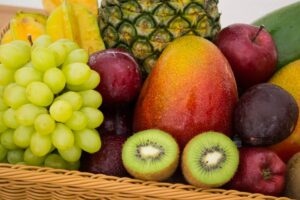FRUIT AND DIABETES

If you have diabetes or are at risk, you may be confused about fruit. Is it a healthy choice or something you should be avoiding due to its sugar content?
It is true that fruit contains natural fruit sugars but in whole fruit this is packaged along with fibre, vitamins and minerals. This makes it a healthy choice for everyone, including people with diabetes. Most fruits also have a low or moderate glycemic index (GI) which means they don’t raise blood glucose levels quickly.
Several studies have found that those who eat more fruit have a lower risk of developing type 2 diabetes. And in those with diabetes, higher intakes of fresh fruit have been associated with a lower risk of death and diabetes-related complications.
These findings are supported by recently published results from 7675 participants in the Australian Diabetes, Obesity and Lifestyle Study (AusDiab). At baseline, total fruit intake was inversely associated with fasting insulin levels and positively associated with measures of insulin sensitivity, after adjusting for multiple confounding factors. This means that people who ate more fruit had lower fasting insulin levels and better insulin sensitivity, putting them at lower risk of developing type 2 diabetes.
Around 60% of participants (4674) were followed up for 5 years to see whether they developed diabetes. Compared to participants with the lowest fruit intakes (an average of 62g per day), participants with moderate total fruit intakes (an average of 230g per day) had 36% lower odds of having diabetes, after adjusting for dietary and lifestyle confounders.
A smaller number of participants (3518) were followed up for 12 years. The researchers again found a lower risk of diabetes for those eating moderate to high intakes of fruit, but the associations were not statistically significant after adjusting for other factors that might affect diabetes risk.
The most commonly eaten fruits in this study were apples, bananas and oranges.
The message from these studies is that whole fresh fruit is a healthy choice for people with and at risk of type 2 diabetes. It makes a great option if you are looking for a sweet snack or dessert. And while all fruits are fine to include in a healthy diet, lower GI fruits including temperate fruits (e.g., apples and pears), citrus fruits (e.g., oranges, mandarins and grapefruit), stone fruits (e.g., peaches, plums, nectarines and apricots) and berries will cause a more gradual rise in blood glucose levels compared to other fruits.
Read more:
- Bondonno NP, and colleagues. Associations between fruit intake and risk of diabetes in the AusDiab cohort. J Clin Endocrinol Metab. 2021.
- Muraki I, and colleagues. Fruit consumption and risk of type 2 diabetes: results from three prospective longitudinal cohort studies. BMJ. 2013.
- Du H, and colleagues; China Kadoorie Biobank study. Fresh fruit consumption in relation to incident diabetes and diabetic vascular complications: A 7-y prospective study of 0.5 million Chinese adults. PLoS Med. 2017.

Dr Kate Marsh is an is an Advanced Accredited Practising Dietitian, Credentialled Diabetes Educator and health and medical writer with a particular interest in plant-based eating and the dietary management of diabetes and polycystic ovary syndrome (PCOS).
Contact: Via her website www.drkatemarsh.com.au







